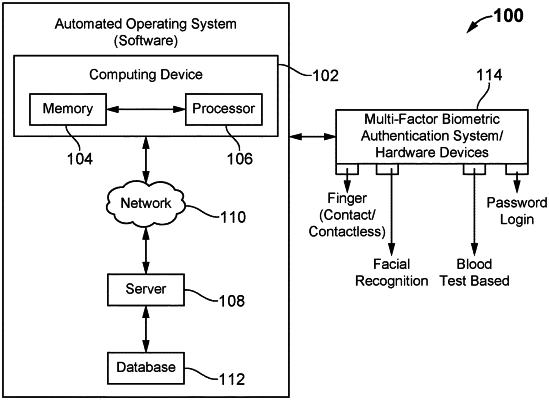| CPC H04L 63/0861 (2013.01) [G06F 16/9035 (2019.01); H04L 63/083 (2013.01)] | 10 Claims |

|
1. An automated operating system for automatically generating profiles for individuals, comprising,
a computing device that comprises a processor and a memory feature and having a software module executed by the processor, wherein the software module is at least one of a plugin component and/or a browser extension,
wherein the processor is in communication with a server via a network and configured to execute a set of instructions stored in the memory;
a database in communication with the server configured to store data related to a user's profile, wherein the database comprising one or more program modules, which are executed by the processor to perform multiple operations, comprising:
creating a plurality of user profiles or personal accounts and automatically save unlimited amounts of computing device information and their associated user generated information under the same unique user profiles that were created automatically through the use and interaction of a sensory group consisting of onboard biometric sensors on a hardware device or user device or a multi-factor biometric authentication system, wherein the onboard biometric sensors are configured to test a blood sample, detect a fingerprint mark, a contactless finger print method of detection, a facial detection, an iris detection, and wherein one or more detected biometric information is sent to an analysis module and said database, thereby the detected biometric information is compared with an existing database in the analysis module to check whether the user's profile and respective login information are already exists in the first instance, and if any one of detected biometric information of a user found to be not available, then a new user profile is automatically created and stored in any one of the analysis module or the database and enables automatic generation of password thereby enabling the user to login and use a particular type of computing device; wherein, any one of content created or generated or changed in the particular type of computing device is automatically sent to the automated operating system, stored and updated constantly in a loop like operation without any intervention of the user;
if a user profile already exists after any of the biometric-based sensors detect any such user by the comparison method in the analysis module or database located in the automated operating system, then the user is automatically allowed to log in to any particular hardware or device installed with automated operating system for further use of the particular device, thereby whatever information is interacted and created by the use of any installed software on that particular device is once again sent to the automated operating system and stored and constantly updated in a loop like operation without the intervention of a user thereby enabling the user in ease to access any device from anywhere;
wherein the user's information is first collected by the onboard biometric sensors or the sensory group installed on any device is utilized by the analysis module residing on the server of the automated operating system to create and authenticate a user profile, and each uniquely created user profile consists images of the user, voice, touch-based biometric, an iris recognition (using any one of rear or front-facing camera), finger prints, a retinal scan, DNA sample, a palm print, a hand geometry, odor/scent, and gait;
generating passwords automatically associated with the plurality of user profiles related to any number of unique devices and unique respective profiles to automatically log in and use respective devices without any manual input of a user;
wherein the users further can change the auto generated passwords associated with his or her user profile or personal account if such maybe desired for manual login by a textual password input method;
thereby the automated operating system enable a user to automatically log in or log out based on mere presence or absence to the visible proximity of any hardware device from anywhere using the auto-created user profile or personal account based on any hardware device and its profile by the use of the multi-factor biometric authentication system in tandem with the analysis module of the automated operating system as needed from time to time;
any number or different users can use the same hardware device(s) by being automatically logged into those devices by the multi-factor biometric authentication method of the automated operating system that has the aforesaid analysis module or database of all user records saved centrally and thereby also not only get logged into the respective or same hardware devices to be used but also to automatically get or retrieve the content that may have been already saved of each hardware profile in each respective user's account and its corresponding content, then retrieved automatically to that particular hardware device and even auto configured to it if such maybe needed for a user to start using it, if the hardware device allows it, a user can also preview in a thumbnail like representation all the various hardware profiles saved in the user's account centrally in one section or window on that particular hardware device the user may have logged automatically into.
|